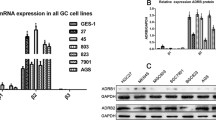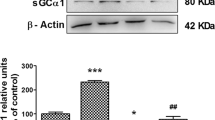Abstract
Stress hormones have been implicated in both tumor initiation and progression. Human telomerase reverse transcriptase (hTERT) is overexpressed in cancer cells and associated with malignant tumor progression and poor outcome. We thus sought to determine whether the stress hormone norepinephrine (NE) could induce hTERT expression and subsequently ovarian cancer progression. Unexpectedly, NE induced hTERT transcript and protein expression, and subsequently ovarian cancer cell invasion. Pharmacologic inhibition of β2-adrenergic receptor 2 and protein kinase A, as well as silencing of hypoxia-inducible factor-1α and c-Myc expression, profoundly attenuated NE-induced hTERT expression. Strikingly, stimulation of the cells with NE or ectopic expression of hTERT induced expression of Slug, ovarian cancer cell epithelial–mesenchymal transition (EMT) and invasion. Silencing of hTERT expression abrogated NE-induced ovarian cancer cell invasion, EMT and Slug expression. In addition, silencing of Slug expression significantly inhibited NE- and hTERT-induced ovarian cancer cell EMT and invasion. Moreover, continuous exposure to NE was sufficient to enhance in vivo hTERT expression and metastasis of ovarian cancer cells to the lung. Finally, we provide evidence that hTERT links Src to Slug expression in NE-induced ovarian cancer EMT and metastasis. We thus demonstrate a novel role of hTERT in stress hormone-induced ovarian cancer aggressiveness through inducing Slug, providing novel biomarkers and potential therapeutic targets for ovarian cancer.
This is a preview of subscription content, access via your institution
Access options
Subscribe to this journal
Receive 50 print issues and online access
$259.00 per year
only $5.18 per issue
Buy this article
- Purchase on Springer Link
- Instant access to full article PDF
Prices may be subject to local taxes which are calculated during checkout







Similar content being viewed by others
References
Fredriksson JM, Lindquist JM, Bronnikov GE, Nedergaard J . Norepinephrine induces vascular endothelial growth factor gene expression in brown adipocytes through a beta-adrenoreceptor/cAMP/protein kinase A pathway involving Src but independently of Erk1/2. J Biol Chem 2000; 275: 13802–13811.
Schmidt C, Kraft K . Beta-endorphin and catecholamine concentrations during chronic and acute stress in intensive care patients. Eur J Med Res 1996; 1: 528–532.
Goldstein DS . Catecholamines 101. Clin Auton Res 2010; 20: 331–352.
McEwen BS . Sex, stress and the hippocampus: allostasis, allostatic load and the aging process. Neurobiol Aging 2002; 23: 921–939.
Kemp VH, Hatmaker DD . Stress and social support in high-risk pregnancy. Res Nurs Health 1989; 12: 331–336.
Lutgendorf SK, Cole S, Costanzo E, Bradley S, Coffin J, Jabbari S et al. Stress-related mediators stimulate vascular endothelial growth factor secretion by two ovarian cancer cell lines. Clin Cancer Res 2003; 9: 4514–4521.
Sood AK, Bhatty R, Kamat AA, Landen CN, Han L, Thaker PH et al. Stress hormone-mediated invasion of ovarian cancer cells. Clin Cancer Res 2006; 12: 369–375.
Armaiz-Pena GN, Allen JK, Cruz A, Stone RL, Nick AM, Lin YG et al. Src activation by beta-adrenoreceptors is a key switch for tumour metastasis. Nat Commun 2013; 4: 1403.
Riley V . Mouse mammary tumors: alteration of incidence as apparent function of stress. Science 1975; 189: 465–467.
Saul AN, Oberyszyn TM, Daugherty C, Kusewitt D, Jones S, Jewell S et al. Chronic stress and susceptibility to skin cancer. J Natl Cancer Inst 2005; 97: 1760–1767.
Thaker PH, Han LY, Kamat AA, Arevalo JM, Takahashi R, Lu C et al. Chronic stress promotes tumor growth and angiogenesis in a mouse model of ovarian carcinoma. Nat Med 2006; 12: 939–944.
Hassan S, Karpova Y, Baiz D, Yancey D, Pullikuth A, Flores A et al. Behavioral stress accelerates prostate cancer development in mice. J Clin Invest 2013; 123: 874–886.
Blackburn EH . Structure and function of telomeres. Nature 1991; 350: 569–573.
Harley CB, Futcher AB, Greider CW . Telomeres shorten during ageing of human fibroblasts. Nature 1990; 345: 458–460.
Kim NW, Piatyszek MA, Prowse KR, Harley CB, West MD, Ho PL et al. Specific association of human telomerase activity with immortal cells and cancer. Science 1994; 266: 2011–2015.
Cong YS, Wright WE, Shay JW . Human telomerase and its regulation. Microbiol Mol Biol Rev 2002; 66: 407–425.
Shay JW, Bacchetti S . A survey of telomerase activity in human cancer. Eur J Cancer 1997; 33: 787–791.
Meng E, Taylor B, Ray A, Shevde LA, Rocconi RP . Targeted inhibition of telomerase activity combined with chemotherapy demonstrates synergy in eliminating ovarian cancer spheroid-forming cells. Gynecol Oncol 2012; 124: 598–605.
Stewart SA, Hahn WC, O'Connor BF, Banner EN, Lundberg AS, Modha P et al. Telomerase contributes to tumorigenesis by a telomere length-independent mechanism. Proc Natl Acad Sci USA 2002; 99: 12606–12611.
Liu Z, Li Q, Li K, Chen L, Li W, Hou M et al. Telomerase reverse transcriptase promotes epithelial–mesenchymal transition and stem cell-like traits in cancer cells. Oncogene 2012; 32: 4203–4213.
Low KC, Tergaonkar V . Telomerase: central regulator of all of the hallmarks of cancer. Trends Biochem Sci 2013; 38: 426–434.
Park SY, Kang JH, Jeong KJ, Lee J, Han JW, Choi WS et al. Norepinephrine induces VEGF expression and angiogenesis by a hypoxia-inducible factor-1alpha protein-dependent mechanism. Int J Cancer 2011; 128: 2306–2316.
Chida Y, Hamer M, Wardle J, Steptoe A . Do stress-related psychosocial factors contribute to cancer incidence and survival? Nat Clin Pract Oncol 2008; 5: 466–475.
Kyo S, Kanaya T, Takakura M, Tanaka M, Yamashita A, Inoue H et al. Expression of human telomerase subunits in ovarian malignant, borderline and benign tumors. Int J Cancer 1999; 80: 804–809.
Yatabe N, Kyo S, Maida Y, Nishi H, Nakamura M, Kanaya T et al. HIF-1-mediated activation of telomerase in cervical cancer cells. Oncogene 2004; 23: 3708–3715.
Greenberg RA, O'Hagan RC, Deng H, Xiao Q, Hann SR, Adams RR et al. Telomerase reverse transcriptase gene is a direct target of c-Myc but is not functionally equivalent in cellular transformation. Oncogene 1999; 18: 1219–1226.
Wiener JR, Windham TC, Estrella VC, Parikh NU, Thall PF, Deavers MT et al. Activated SRC protein tyrosine kinase is overexpressed in late-stage human ovarian cancers. Gynecol Oncol 2003; 88: 73–79.
Yu ST, Chen L, Wang HJ, Tang XD, Fang DC, Yang SM . hTERT promotes the invasion of telomerase-negative tumor cells in vitro. Int J Oncol 2009; 35: 329–336.
Ghosh JS, Rokade KB . Biodegradation of 2-mercaptobenzothiazolyl-(Z)-(2-aminothiazol-4-yl)-2-(tert-butoxycarbonyl) isopropoxyiminoacetate by Pseudomonas desmolyticum NCIM 2112. Appl Microbiol Biotechnol 2012; 93: 753–761.
Ghosh A, Saginc G, Leow SC, Khattar E, Shin EM, Yan TD et al. Telomerase directly regulates NF-kappaB-dependent transcription. Nat Cell Biol 2012; 14: 1270–1281.
Zhang C, Carl TF, Trudeau ED, Simmet T, Klymkowsky MW . An NF-kappaB and slug regulatory loop active in early vertebrate mesoderm. PLoS ONE 2006; 1: e106.
Tothill RW, Tinker AV, George J, Brown R, Fox SB, Lade S et al. Novel molecular subtypes of serous and endometrioid ovarian cancer linked to clinical outcome. Clin Cancer Res 2008; 14: 5198–5208.
Sloan EK, Priceman SJ, Cox BF, Yu S, Pimentel MA, Tangkanangnukul V et al. The sympathetic nervous system induces a metastatic switch in primary breast cancer. Cancer Res 2010; 70: 7042–7052.
Nilsson MB, Armaiz-Pena G, Takahashi R, Lin YG, Trevino J, Li Y et al. Stress hormones regulate interleukin-6 expression by human ovarian carcinoma cells through a Src-dependent mechanism. J Biol Chem 2007; 282: 29919–29926.
Yang EV, Sood AK, Chen M, Li Y, Eubank TD, Marsh CB et al. Norepinephrine up-regulates the expression of vascular endothelial growth factor, matrix metalloproteinase (MMP)-2, and MMP-9 in nasopharyngeal carcinoma tumor cells. Cancer Res 2006; 66: 10357–10364.
Chakroborty D, Sarkar C, Basu B, Dasgupta PS, Basu S . Catecholamines regulate tumor angiogenesis. Cancer Res 2009; 69: 3727–3730.
Wang Y, Yue B, Yu X, Wang Z, Wang M . SLUG is activated by nuclear factor kappa B and confers human alveolar epithelial A549 cells resistance to tumor necrosis factor-alpha-induced apoptosis. World J Surg Oncol 2013; 11: 12.
Park JI, Venteicher AS, Hong JY, Choi J, Jun S, Shkreli M et al. Telomerase modulates Wnt signalling by association with target gene chromatin. Nature 2009; 460: 66–72.
Sakai D, Tanaka Y, Endo Y, Osumi N, Okamoto H, Wakamatsu Y . Regulation of Slug transcription in embryonic ectoderm by beta-catenin-Lef/Tcf and BMP-Smad signaling. Dev Growth Differ 2005; 47: 471–482.
Lambertini E, Franceschetti T, Torreggiani E, Penolazzi L, Pastore A, Pelucchi S et al. SLUG: a new target of lymphoid enhancer factor-1 in human osteoblasts. BMC Mol Biol 2010; 11: 13.
Chao C, Goluszko E, Lee YT, Kolokoltsov AA, Davey RA, Uchida T et al. Constitutively active CCK2 receptor splice variant increases Src-dependent HIF-1 alpha expression and tumor growth. Oncogene 2007; 26: 1013–1019.
Barone MV, Courtneidge SA . Myc but not Fos rescue of PDGF signalling block caused by kinase-inactive Src. Nature 1995; 378: 509–512.
Higgins DF, Kimura K, Bernhardt WM, Shrimanker N, Akai Y, Hohenstein B et al. Hypoxia promotes fibrogenesis in vivo via HIF-1 stimulation of epithelial-to-mesenchymal transition. J Clin Invest 2007; 117: 3810–3820.
Wolfer A, Ramaswamy S . MYC and metastasis. Cancer Res 2011; 71: 2034–2037.
Lara HE, Dorfman M, Venegas M, Luza SM, Luna SL, Mayerhofer A et al. Changes in sympathetic nerve activity of the mammalian ovary during a normal estrous cycle and in polycystic ovary syndrome: studies on norepinephrine release. Microsc Res Technol 2002; 59: 495–502.
Lara HE, Porcile A, Espinoza J, Romero C, Luza SM, Fuhrer J et al. Release of norepinephrine from human ovary: coupling to steroidogenic response. Endocrine 2001; 15: 187–192.
Nakayama J, Tahara H, Tahara E, Saito M, Ito K, Nakamura H et al. Telomerase activation by hTRT in human normal fibroblasts and hepatocellular carcinomas. Nat Genet 1998; 18: 65–68.
Lee J, Park SY, Lee EK, Park CG, Chung HC, Rha SY et al. Activation of hypoxia-inducible factor-1alpha is necessary for lysophosphatidic acid-induced vascular endothelial growth factor expression. Clin Cancer Res 2006; 12: 6351–6358.
Jeong KJ, Park SY, Cho KH, Sohn JS, Lee J, Kim YK et al. The Rho/ROCK pathway for lysophosphatidic acid-induced proteolytic enzyme expression and ovarian cancer cell invasion. Oncogene 2012; 31: 4279–4289.
Seo JH, Jeong KJ, Oh WJ, Sul HJ, Sohn JS, Kim YK et al. Lysophosphatidic acid induces STAT3 phosphorylation and ovarian cancer cell motility: their inhibition by curcumin. Cancer Lett 2010; 288: 50–56.
Park SY, Jeong KJ, Panupinthu N, Yu S, Lee J, Han JW et al. Lysophosphatidic acid augments human hepatocellular carcinoma cell invasion through LPA1 receptor and MMP-9 expression. Oncogene 2011; 30: 1351–1359.
Palm D, Lang K, Niggemann B, Drell TLt, Masur K, Zaenker KS et al. The norepinephrine-driven metastasis development of PC-3 human prostate cancer cells in BALB/c nude mice is inhibited by beta-blockers. Int J Cancer 2006; 118: 2744–2749.
Acknowledgements
We thank Professor Bong-Kyeong Oh (KonKuk University, Seoul, South Korea) for a plasmid-containing hTERT, Sun Hee Leem (Dong-A University, Pusan, Korea) for hTERT promoter and Seong-Lan Yu for experimental support. This study was supported by a grant from the National R&D Program for Cancer Control, Ministry of Health & Welfare, Republic of Korea (121182) and Basic Science Research Program through the National Research Foundation of Korea (NRF) funded by the Ministry of Education, Science and Technology (2011-0015761, 2013R1A1A2A10059565).
Author information
Authors and Affiliations
Corresponding author
Ethics declarations
Competing interests
The authors declare no conflict of interest.
Additional information
Supplementary Information accompanies this paper on the Oncogene website
Rights and permissions
About this article
Cite this article
Choi, M., Cho, K., Lee, S. et al. hTERT mediates norepinephrine-induced Slug expression and ovarian cancer aggressiveness. Oncogene 34, 3402–3412 (2015). https://doi.org/10.1038/onc.2014.270
Received:
Revised:
Accepted:
Published:
Issue Date:
DOI: https://doi.org/10.1038/onc.2014.270
This article is cited by
-
Chronic stress in solid tumor development: from mechanisms to interventions
Journal of Biomedical Science (2023)
-
Hormonal regulation of telomerase activity and hTERT expression in steroid-regulated tissues and cancer
Cancer Cell International (2022)
-
CREB1 contributes colorectal cancer cell plasticity by regulating lncRNA CCAT1 and NF-κB pathways
Science China Life Sciences (2022)
-
rno-miR-128-3p promotes apoptosis in rat granulosa cells (GCs) induced by norepinephrine through Wilms tumor 1 (WT1)
In Vitro Cellular & Developmental Biology - Animal (2021)
-
The emerging roles of circular RNAs in ovarian cancer
Cancer Cell International (2020)



